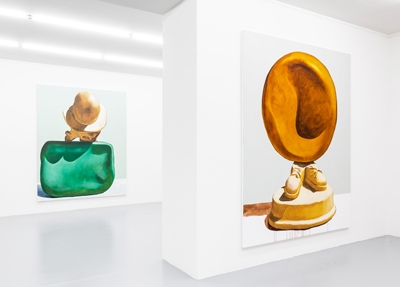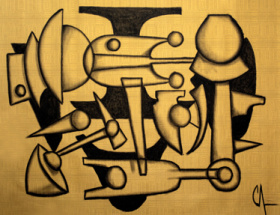A Repressed Shout
By Nathalie M. Sánchez
When the artist’s mind is full of convulse thoughts, his hand becomes a sort of personal narrator. The creator has the tools to realize the idea; he just needs to paint “a repressed shout” in order to shine on the support.
The artists’ need to express their most intimate passions has found an echo in humanist discourses. Cuban creators are no exception in this regard, since that will of defense, concern and criticism regarding the individual and way of life in postmodern society has been reflected to a greater or lesser extent in our context. The greatest achievement belongs to the artists whose intelligence allows them to say the same but differently.
When the most valuable aspect of creation is not what is said but how it is represented, it becomes necessary to stop before the work of Danco Robert Duportai (Havana, 1997), a young man with the ability to charm with this creative capacity.
His works impact by the nature of his support: staples that he covers with oil paint and joins to produce images of only 3-4 cm formed by pieces as of a puzzle, as scenes of fragile memories.
His models are conceived from color spots, showing particular interest for expressionist figuration. Each brush stroke is autonomous when creating the forms of the figures. His “minimalist” expressionism establishes a majestic communication. Creating in reduced spaces forces him to stop more in the details; that is why he is able to effectively capture vibrations, sensations and unsteadiness.
In pieces like 16 de marzo. 6:00 pm, Gottfried Helnwein’s piece Stress and Munch’s famous and iconic shout seem to fuse in a single painting. Although the three artists are distant in context, they share the intention of presenting us with the individual whose image projects the alteration of the spirit and easy disorder of the senses. Once more we are faced with a sharp, mute and desperate shout. Danco’s piece, in turn, does not show the deformity that is present in Munch’s whole conception of his painting. Nor is the exquisiteness in the details to be perceived that stands out in the hyperrealism highlighted by Gottfried, that master of the surprising recognition. His expressionism is a more intimate, more tempered, but more ailing one. It would seem as if the reasons that torment the character are less abstract and deeper than those of the other authors.
What marks the difference in Danco’s work is precisely the staple as support, undoubtedly an innovative and daring element, but not in the least a random one. He could paint on canvas (which in fact he does); however, he has let himself be carried away by his ingeniousness and succeeds in exploiting the possibilities offered by this material. Challenging the alleged scarce durability and complexity of painting on the staple pieces, he pretends to show us a scene constructed from a series of mini scenes, where the pieces could be assembled and taken to pieces, then inverting their order to create a new work.
The fragmentation of reality, in addition to granting new meaning to the work, evo kes that sensation of vagueness and fragility produced by the memory. This makes him not only a postmodern creator but an artist who understands that the value of art starts with the study to conceive the piece and is completed with the public’s intervention.
Danco has that ability to combine form and content effectively in a format of only a few centimeters. More than a painter he is a minimalist creator and an expert in communicating the physical condition of a repressed shout.



